1. Origin and meaning
The word sudarshan chakra (सुदर्शन चक्र) is derived from two words, su (सु) and darshan (दर्शन). It means the vision (darshan) of which is auspicious (su). The word chakra is derived from chruhu (चृ:)which means movement and kruhu (कृ:) which means to do. Thus, chakra means that which is constantly in motion. Of all weapons, this is the only one which is in constant motion.
2. Creation and history
There are various schools of thought regarding its creation as given below.
A. It was created by the combined energy of Brahma, Vishnu and Mahesh.
B. This was given by Bruhaspati to Vishnu.
C. Krushna procured it from the deities (devatamandal).
D. Krushna and Arjun assisted the fire deity (Agni) in burning the Khandav forest. In return He presented Krushna with a Sudarshan-chakra and a koumodaki mace.
E. Female deities like Narayani, Vaishnodevi, etc. also wield discuses in their hands
3. Special features
A. Krushna usually holds the Sudarshan-chakra on His little finger while Vishnu on His index finger. However, when releasing it, Shri Krushṇa uses His index finger. In Shri Krushṇa’s picture, since He is engaged in a battle (Fighting a battle, in marak form), the Sudarshan chakra has been depicted on His index finger instead of on His little finger.
B. After its release, the enemy is annihilated and it returns to the one who has wielded it.
C. Even after releasing it, it remains within the control of the one who has wielded it.
D. It travels along the shunyamarg (path of zero stress nature) and hence, can reach anywhere
within a moment.
E. When the enemy poses an obstacle, its speed increases. This is known as the hansagati.
F. It is noiseless.
4. Composition
Information with regard to its composition is as given below.
A. ‘It is said that it has six spokes and its centre is composed of vajra. It is believed that the words “Sahasrat hum phat (सहस्रात् हुं फट्)” are inscribed on each of the spokes.
B. A novel description of the discus has been made in the Vaman Puran (82.23-26). Mr. Vasudevsharan Agraval expresses it as: The discus has been described as the discus of time (kalachakra). It consists of twelve spokes (Dvadashar, Rugveda 1.164.11) and six navels. The twelve spokes represent the twelve months of the Hindu lunar calender and also the twelve deities (Vij, Agni, Som, Mitra, Varun, Indra, Indragni, Vayu, Vishvedev, Prajapati, Dhanvantari, etc.). The six navels represent the six seasons.’
C. Parts of the Sudarshan chakra and the implied meaning
- The middle stable part: It is named bhruvi (equality), bhag (radiance), nirdesh (speed) and sampada (endowed with the nectar of nutrition).
- The spokes: It has twenty-seven spokes charged with the run energy of the twenty-seven feminine principles created from Prajapati. These spokes contain the yoginipanchak, that is the basic components of the five cosmic elements. The energy in all feminine principles is beyond the restrictions of direction and time.
- Yogini : ‘योगं नियते इति’ means the one who bestows the energy which is unattainable.
- Lakshmi : The one who bestows one with the achievement of the target (lakshyam) or the absolute truth.
- Narayani : All pervading
- Murdhini : Murdha is the linear part included in the longitudinal section between the centre of the eyebrows and the vertebral column. It is referred to as the line of the head (mastakresha). Murdhini refers to the frequencies which intersect the head directly. These frequencies are present in rudrakshas too. Murdhini or Murdhivahini refers to that which flows through the murdha.
- Randhra : The speed or energy which transforms into the subtlemost.
- Parigh : This is constituted by the following eight masculine principles.
- Aditya : ‘आदि: अत:’ means the radiance which first came into existence and is still persisting.
- Varuni : Varun is the deity of water. Varun exercises control over the dikbhavs, that is those created from the directions. The dikbhavs are the main centres of the directions. Hence no matter in which direction the discus travels, it is never obstructed.
- Juhu : The subtlemost speed which is enriched with the radiance (jyoti) derived from the lunar asterisms.
- Indra : Frequencies displaying greatness.
- Narayan : The one endowed with the energy of movement of the Navanarayans, the nine serpents [from the universal spiritual energy flow system (kundalini)]
- Navadha : The Navanarayan, navanag and navavidh concept combined together mean navadha.
- Gandhi : Those who can travel on the earth.
- Mahish : The Blissful principle in Mahesh.
- Size of the discus : It is so tiny that it can be kept on the tip of a leaf of the tulsi plant and at the same time is so huge that it can encompass the entire universe.
5. Illustrations of its use
A. When Shri Krushna lifted the Govardhan mountain for support He held the Sudarshan chakra below it.
B. Krushna used it to slay Shishupal.
C. It was used to create an artificial sunset so that Jayadrath could be annihilated. However it was not used by Krushna in the Bharatiya war or in any other battle to slay anyone.
D. When Arjun said that Hanuman (Maruti) would not be able to break the bridge of arrows created by him, although Maruti jumped on it, it did not break. This was because to help His friend Arjun, Krushna had supported the bridge placing His Sudarshan chakra below it.
E. When Shri Vishṇu was enraged with Sage Durvas for having needlessly cursed His beloved devotee King Ambarish, He hurled the Sudarshan chakra at the Sage. The petrified Sage ran to the Deities, but none could rescue Him. Finally, when He went to Shri Vishṇu, He told the Sage to beg the king for forgiveness. When the Sage complied, Shri Vishṇu withdrew His Sudarshan chakra.
F. It is quoted in a holy text of the Nath sect that once Gorakshanath had stopped the Sudarshan chakra.
6. Science behind the idol
The Idol of Sudarshan is ferocious. It has sixteen arms adorned with a conch, a chakra, a bow, an axe, a sword, an arrow, a pike, a noose, a goad, fire, a rhinoceros horn, a shield, a plough, a pestle, a mace and a spear as weapons. In some places, it is customary to consider an Idol of Sudarshan chakra as that of Shri Vishṇu.
Reference: Sanatan’s Holy text, ‘Shrivishnu, Shriram and Shrikrushna‘

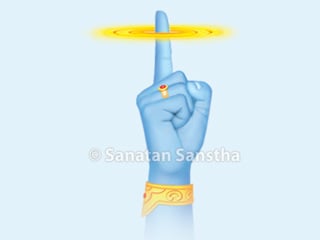
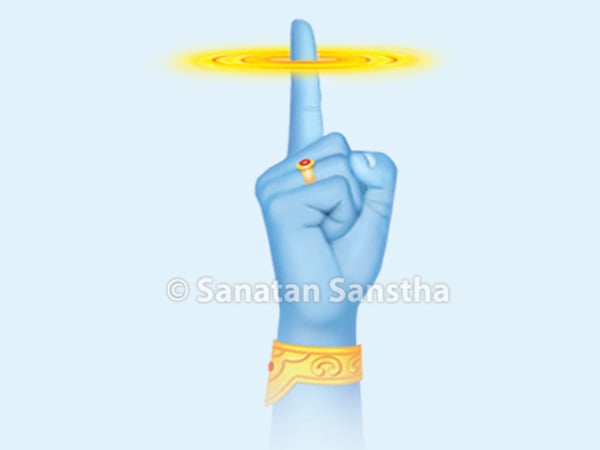
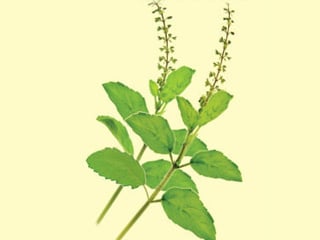 Why are tulsi leaves offered to Shri Krishna ?
Why are tulsi leaves offered to Shri Krishna ?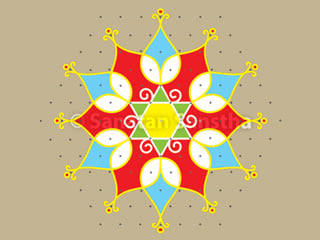 Shri Krishna Rangoli - Rangoli designs associated with Shri Krishna
Shri Krishna Rangoli - Rangoli designs associated with Shri Krishna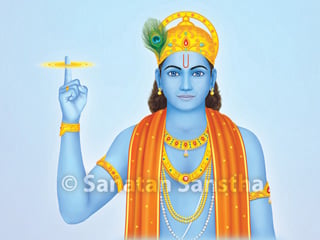 Ritualistic worship of Shri Krishna
Ritualistic worship of Shri Krishna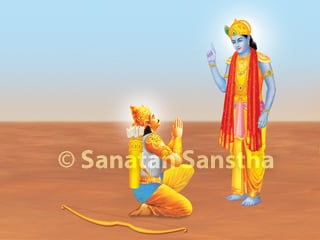 Why did Shri Krushna narrate Gita only to Arjun ?
Why did Shri Krushna narrate Gita only to Arjun ?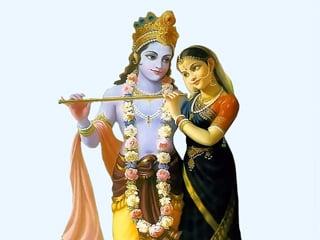 What is the real relationship between Radha and Shri Krishna ?
What is the real relationship between Radha and Shri Krishna ?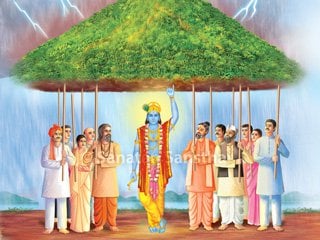 Why is incarnation of Shri Krishna considered as absolute ?
Why is incarnation of Shri Krishna considered as absolute ?